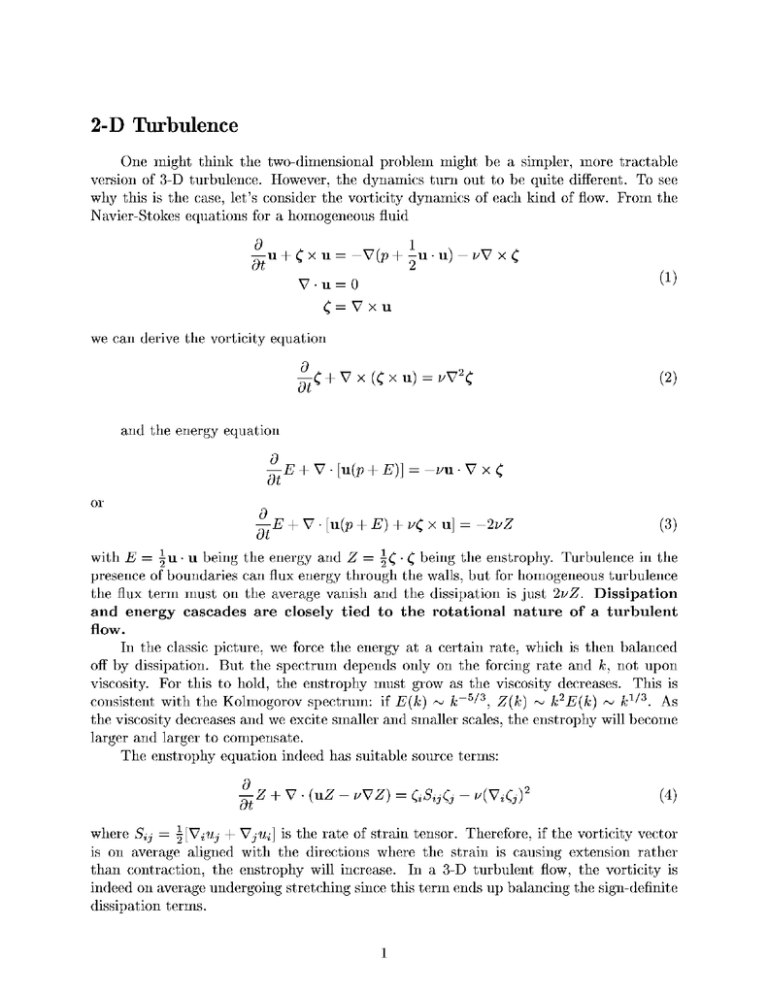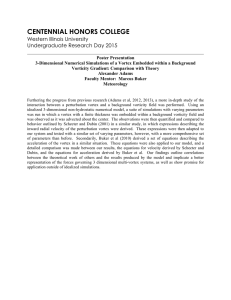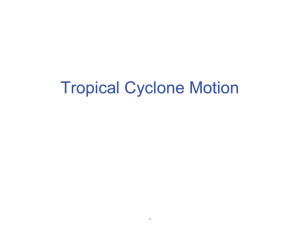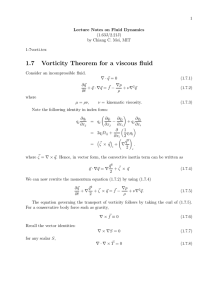Document 13568064
advertisement

2-D Turbulence
One rnight think the two-tlirnensional problem rrligllt be a sirnpler, more tractable
version of 3-D turbulence. However) the dynarnics turn out to be quite different. To see
why this is the case, let's consider the vorticity dynarnics of each kirld of flow. Frorn the
Navier-Stokes equations for a homogeneous fluid
we can derive the vorticity equation
and the energy equatiorl
+<. <
wit11 E = i u . u 1)eing the energy and Z =
being the enstrophy. Tur1)ulence in the
presence of boundaries can flux energy through the walls. hut for homogeneous turbulence
the flux terrn rrlust on the average vanish and the dissipation is just 2vZ. Dissipation
and energy cascades are closely tied to the rotational nature of a turbulent
flow.
In the classic picture, we force the energy at a certain rate; which is then balanced
off by dissipation. But the spectrurn depends only on the forcing rate and k : not upon
viscosity. For this to hold, the enstropl~yrrrlust grow as the viscosity decreases. This is
consistent wit11 the Kolrnogorov s1)ectrurn: if E ( k ) k p 5 / 3 : Z ( k ) k 2 E ( k ) k1l3. As
the viscosity decreases ant1 we excite smaller and srrlaller scales) the enstropl~ywill becorne
larger and larger to cornpensate.
The enstropl~yequation intleed has suitable source terrns:
N
+
-
N
1
where SiJ = ?[Viuj
V j u i ]is the rate of strain tensor. Therefore, if the vorticity vector
is on average aligned wit11 the directions where the strain is causing extension rather
than corltraction; the enstrophy will increase. In a 3-D turbulent flow, the vorticity is
irltleed on average undergoing stretching since this term entls up balancing the sign-definite
dissipation terrns.
The two-tlirnensional systern differs significarltly in its vorticity dynamics. Since u . i =
0 and &U = 0, the vorticity is purely vertical = Cz. The enstrophy production terrn
hecornes
<
C,iS,i,C,
Z
~
W
= c2s33= ( - = 0
az
In a 2D system, the energy and enstrophy will decay monotonically
Since the enstroplly is bounded by its initial value, the energy dissipation rate will decrease
in proportion to the viscosity; an energy cascade in the Kolnnogorov sense will not occur.
However the terrr~giving dissipation of enstropl~ywill have a non-trivial generation
term; this follows frorn the vorticity equation
and examination of the tlissipation~tern11 -vV(I2 If we let g = VC and G = ; V C 2 the11
If the corltours of vorticity are aligned with the axis of extension, the gradients will be
aligned with the axis of cornpression and the vorticity lines will be pushed closer together,
increasing the rrlean square gradient. Thus enstrophy (can cascade, since there is a source
terrn for vorticity gratlierlts.
These results suggest that we could derive a spectrurn frorn an enstrophy (cascade
L3/T2) should depend on k (Lpl) arid the rate of enstroplly
argurner~t:E ( k ) (ctlirnensio~~s
dissipation TI = v(V,igi)' (which has tlirr~ensionsTp3). The result is
with the enstropl~yspectrurn also decreasing at srnall scales Z ( k )
N
kpl.
2D simulations
What does 2-D turbulence look like? We show results frorn a 512x512 2-D pseudospectral code solvir~gthe vorticity equatior~and the inversion of vorticity to fir~tlthe
strearnfunction.
3
-C
J ( $ , C ) = filter
at
+
Demos, Page 2: 2D < p s i > < z e t a >
Demos, Page 2: S t a t i s t i c s < s p e c t r a >
<E and Z>
<variance and
<pdf of z e t a >
Demos, Page 2: Averages
k u r t o s i s > The strearnfunction shows a marked increase in scale the so-called "irlverse
cascade" while the vorticity collects ir~ttostrong isolated vortices with filamentary structure
in between. The PDF and the kurtosis of the vorticity field shows the non-Gaussian nature
of the flow quite clearly.
-
Inverse cascade
We car1 quan~tifythe irlverse cascade using an argurner~tof Peter Rhines: consider the
average scale, defined as
We note tlvat E = J E ( k ) ant1 Z = J k 2 E ( k ) are conservetl in irlviscid rnotion. If we
presume the energy is initially near ko and is spreading then
Therefore
As the energy spreatls in the spectrurn its rnean scale increases.
k
<kbar v s time>
Demos, Page 3:
mean
Multiple power laws
We now have two possil>lepower laws: the K41 law
and the enstropl~ycascade law
E
N
,,/2/3k-3
In the first case) the enstrophy transfer rate rrlust be zero since then r/ k 2 t which will
not 1x3 independent of k un~lessthe coefficier~tis zero. Similarly: the energy cascade rate
will be zero in the second case.
Calculations of the transfer rates (c.f. Kraichnanl 1967) show that K41 gives upscale
energy transfer while k p 3 gives tlownscale enstropl~ytransfer. We rnigl~t(consider using
the forrr~erin the range k < ki,j,,ti ,, and the latter for srr~allerscales k > ki,,,j,,ti,,.
.
I
Problems with the power law spectra
The assumption in the sirr~ilarityrnodels is that the turn-over tirne at scale k depentls
on the net shear/ strain at that scale
For K41; this gives
,qz
N
k4/3
-
k4/3
0
which is dominated by the cor~trihutionnear k
the transfers are local. The estirnate of
strain corlverges as ko t 0 and 60% is generated frorn k / 2 to k . For the K 3 case: however,
-
which diverges; intleed. the corltribution frorn k/8 to k / 4 is the sarne as frorn k/4 to k / 2
and as that frorn k / 2 to k . Thus the transfers are not local and the argunr~er~t
is not
consistent.
Vortex dynamics
Onsager (19xx) realized that vortex dynarnics rr~igl~t
indeed be a significar~tpart of
2-D turbulence. For the inviscitl problern, a poir~tvortex
is a basic solution in the sense that the irlversion forrrlula from vorticity to strearnfunction
irlvolves the Green's fur~ctionG(x) = log(Ix)/2,rr
To tlerive the forrrlula for G, we locate the origin at the vortex, use syrnrnetry to replace
V2$ wit11 Ti zar $ $ and use the free solution away from r = 0. Irltegrating over a srrrall
disk centered at r = 0 gives the constant in front.
A single vortex tloes not atlvect itself: we can1 think of the nnotion of the poir~tas
associatetl with the average velocity in a srnall tlisk centered at xo. This flow is protlucetl
hy all the other vortices in the flow. Thus, if we have a set of vortices at positions xi, we
have
Kirchhoff (1876) realized that this could be written as a Harniltonian systerr~
3
-F
3t
= { F ,H }
For a srrlall nurr11)er of vortices, this systerr~is integrable: it has 4 conserved properties
(energy, x arltl y cerlters of rnass, angular morner~tunn)vs. 2 ur~kr~owr~s
per vortex. Wit11
rnore than three vortices: however, the nnotions can becorne chaotic.
Demos, Page 5 : Point vortex simulations
<n=3>
<delta solutions> <n=4>
<delta>
<single vortex trajectory>
<long example> Onsager(l941) considered the statistical properties of a rrlarly vortex systerr~and predicted clunrlpir~gof like-signet1 vortices would result, corresponding to a cascatle to larger
scales.
Vortex dynamics
To urlderstarld the rnerger process, let us consitler the irlviscid tlynarrlics of a single
vortex ernbedded in a shear or strain field. We car1 represent the vorticity as
( = { q qo
O+A
and the flow as
1
else
?i, = -qoy2
2
+ li,'
The points on the 1)oundary of D are material poirlts since they separate fluid with tlifferer~t
vorticities. Furthermore, the velocities can be written as a line integral around the patch
hountlary
Thus the evolution of the vorticity contours can be posetl as a tlyrlarr~icalsystern (in fact
a Harniltonian one). We'll analyze linearizetl versior~sbut show fully r~onlirlearexamples.
Perturbed circular vortex
We slvall consider a vortex patch
( = qo
+ A.tl(o, + ~ ( 0t),
-
r)
(where 'U is the step function) and define the circular state
v2$= qo + A.tl(o.
+ +
wit11 li, = iqoy2
$I.
-
r)
+
13 3
--r-v-
r 3 r 3r
1
=A6(a
r2
-?i
The perturbation strearr~functio~~
satisfies
02?i,li,'
= A [%(a+ rl
-
r)
-
'U(a
-
r ) ] -. A$(a
and the condition tlvat the edge be a material surface is
-
r)
-
r)
FR.EEMODES: 111terrr~sof the Green's fur~ctiorl
we have
-
v=-An.gl(r,n)
where ,rlT,, is the
7~~~
,
li,~,,=Ao..~,,,g~,,(r,n)
Fourier ~ o r r ~ p o r ~in
e rangle
~ t 8. The kinerrlatic equation then gives
This has solutions rlTl,
-
exp(ws(B fit)) with
-
Using
more slowly propagating against
gives high rnodes being advected arltl low rnodes rr~ovir~g
the flow because of the vorticity gradient
Demos, Page 7: Vortex waves < c i r c u l a r >
<go>
<n=4>
<go>
<n=8>
<go>
<go>
<n=2>
SHEAR.FLOW: A background shear ir~troducesa forcing of the
therefore limit ourselves to this rr~ode;we have
71,
<go>
<n=3>
= 2 rnode. If we
This has a steatly solution with the vortex elongated along the shear when the sense of
rotation of the shear is the sarrle as the vortex or perpendicular when they have opposite
rlo a
rl2 = -cos 28 =
4n
qoan, cos 28
2 A ( n 1)
-
In general 1' 2 will oscillate around this value: depending on the initial condition. Kitla
(1981) tlernonstrated tlvat an exact nonlinear solutior~to the problerr~is elliptical wit11
Demos, Page 7: Vortices i n
the aspect ratio ant1 orientation cllarlgir~gwith tirne.
shear < e l l i p t i c a l >
<go>
< s t r o n g shear> <go>
<weak shear> <go>
<balanced>
<go>
<adverse>
<go>
<adverse weak>
<go>
TWOVORTICES:
If two vortices are separated widely enough, we can ignore all but the monopole field
of the secontl vortex in the vicinity of the first. In atldition, we look at the first vortex in
a co-rotating frarne. In that case the 1)ackground strearnfur~ctionfield looks like
The first terrn in the Taylor series assurrling R
go
-
4
>> a is
Aa4
" sin2 0 = -- cos 20
---
2 R2
4 R2
Thus the vortex is err~betldedin an opposing shear and car1 be elongated until it meets the
other vortex. In linear theory, the l>oundary tlisplacerr~en~t
is Aa3/4R2C12 and crosses the
centerline when r/ = R/2 a ; this gives a critical separation of 2.4 radii. In fact, rrlerger
Demos, Page 8: Vortices in neighbor
occurs for separations less tllar~3.3 radii.
field <R=4> <go>
<R=3> <go> <R=3.5>
<go> < R = 4 f u l l > <R=3.5
full>
<R=3.45 full>
<R=3.4 full>
<R=3.3 full>
-





